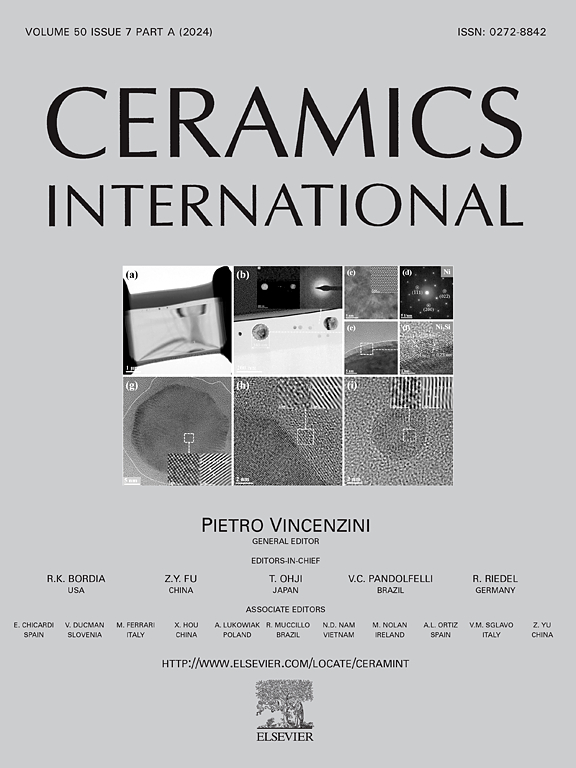Scandia-stabilized zirconia (ScSZ) cathode functional layer fabricated via DC reactive sputtering for low-temperature solid oxide fuel cells
IF 5.1
2区 材料科学
Q1 MATERIALS SCIENCE, CERAMICS
引用次数: 0
Abstract
Solid oxide fuel cell (SOFC) operation at low temperatures is a promising approach for achieving efficient, stable, and reliable electricity generation while significantly reducing carbon emissions. However, slow oxygen reaction kinetics significantly increase interfacial resistance, presenting a significant challenge in lowering the operating temperature. This study explores the use of scandia-stabilized zirconia (ScSZ) as a cathode functional layer (CFL) to enhance oxygen reduction reaction (ORR) kinetics on the electrolyte surface at a low operating temperature of 450 °C. We prepared ScSZ CFL-coated fuel cells using the direct current (DC) reactive sputtering technique to experimentally validate the electrochemical performance. We confirmed that DC reactive sputtering not only reduces deposition time compared to conventional methods but also enables grain size control by adjusting the applied DC power. The ScSZ CFL-coated fuel cells demonstrated that small grains on the electrolyte surface can improve the electrochemical reaction sites for oxygen incorporation by increasing the grain boundary density. The electrochemical performance measurements indicated that the fuel cells coated with ScSZ CFLs at a DC power of 120 W exhibited a peak power density 1.6-fold higher than that of uncoated fuel cells. Electrochemical impedance spectroscopy analysis also revealed that the nanograin surface of the electrolyte significantly contributed to enhancing fuel cell performance by improving ORR kinetics.
低温固体氧化物燃料电池用直流反应溅射制备钪稳定氧化锆(ScSZ)阴极功能层
固体氧化物燃料电池(SOFC)在低温下运行是一种很有前途的方法,可以实现高效、稳定和可靠的发电,同时显著减少碳排放。然而,缓慢的氧反应动力学会显著增加界面阻力,这对降低操作温度提出了重大挑战。本研究探索了在450℃的低温下,利用钪稳定氧化锆(ScSZ)作为阴极功能层(CFL)来增强电解质表面氧还原反应(ORR)动力学。采用直流反应溅射技术制备了ScSZ cfl包覆燃料电池,并对其电化学性能进行了实验验证。我们证实,与传统方法相比,直流反应溅射不仅缩短了沉积时间,而且可以通过调节施加的直流功率来控制晶粒尺寸。ScSZ cfl包覆燃料电池表明,电解质表面的小颗粒可以通过增加晶界密度来改善电化学反应中氧结合的位置。电化学性能测试表明,在直流功率为120 W时,涂覆ScSZ cfl的燃料电池的峰值功率密度比未涂覆ScSZ cfl的燃料电池高1.6倍。电化学阻抗谱分析还表明,纳米颗粒表面的电解质通过改善ORR动力学对燃料电池性能的提高有显著的贡献。
本文章由计算机程序翻译,如有差异,请以英文原文为准。
求助全文
约1分钟内获得全文
求助全文
来源期刊

Ceramics International
工程技术-材料科学:硅酸盐
CiteScore
9.40
自引率
15.40%
发文量
4558
审稿时长
25 days
期刊介绍:
Ceramics International covers the science of advanced ceramic materials. The journal encourages contributions that demonstrate how an understanding of the basic chemical and physical phenomena may direct materials design and stimulate ideas for new or improved processing techniques, in order to obtain materials with desired structural features and properties.
Ceramics International covers oxide and non-oxide ceramics, functional glasses, glass ceramics, amorphous inorganic non-metallic materials (and their combinations with metal and organic materials), in the form of particulates, dense or porous bodies, thin/thick films and laminated, graded and composite structures. Process related topics such as ceramic-ceramic joints or joining ceramics with dissimilar materials, as well as surface finishing and conditioning are also covered. Besides traditional processing techniques, manufacturing routes of interest include innovative procedures benefiting from externally applied stresses, electromagnetic fields and energetic beams, as well as top-down and self-assembly nanotechnology approaches. In addition, the journal welcomes submissions on bio-inspired and bio-enabled materials designs, experimentally validated multi scale modelling and simulation for materials design, and the use of the most advanced chemical and physical characterization techniques of structure, properties and behaviour.
Technologically relevant low-dimensional systems are a particular focus of Ceramics International. These include 0, 1 and 2-D nanomaterials (also covering CNTs, graphene and related materials, and diamond-like carbons), their nanocomposites, as well as nano-hybrids and hierarchical multifunctional nanostructures that might integrate molecular, biological and electronic components.
 求助内容:
求助内容: 应助结果提醒方式:
应助结果提醒方式:


